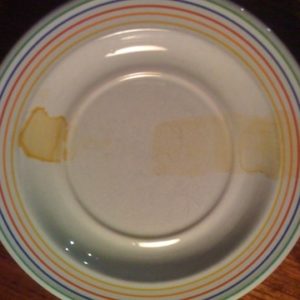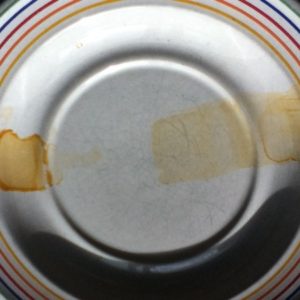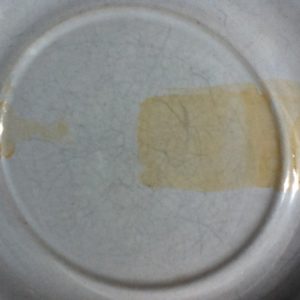Does any body want to look at a few photos of the same plate with a stain on it ?
WHY . . . . you may ask if you haven’t gone right off the idea on sight.
HERE IS WHY . . .
and I think it is some thing to think about when it comes to warnings about what a lame finish shellac is when used by its self on a surface such as a dining table that gets washed often.
The first photo was taken two years ago in December. It is of my test sample before I used Shellac for our dining table. Here is the original post about that :
(Sorry I searched and search for it. Maybe some time soon I will locate it.)
Any way, to test the shellac I figured if I put it on and it washed off when I washed it with the rest of the dishes I would rethink this shellac on the dining table idea. It held up remarkably well; even the highly thinned single layer ( the thinnest, lightest colored area ) was wholly undisturbed. I was encouraged and finished my table with shellac and it is fine after two years of daily use. By adults.
A few days ago I ran across this plate sitting around in my “to be put away pile” and figured I would give it hell just for research purposes and then clean off the rest of the shellac with some alcohol and put the plate back in the cabinet.
I filled the sink with extremely hot tap water and lots of dish soap, I wash dishes with the same nitrile gloves I use in the shop so I always use the hottest water (why not).
I put the dish in the photos in first and piled in all the rest of the dishes. People hate to watch me wash dishes. I fart around and brush and scrub and look and scrub. I think I am doing a good job. Seems like the entire world thinks they can wash dishes better and faster than I can.
(ha, ha, ha so usually I just give in and let ’em ha, ha, ha ) If you really want to go crazy you aught to watch me white wash a fence.
: )
Harumph, harummm ha, ha, . . . where was I ? Oh yah . . .
taking my time soaking this plate in hot hot water.
I washed a l l l l l l the others . . .
and rinsed ’em . . .
and dried ’em . . .
then fished out this poor little sucker, gave it a good rubbing with the wash cloth and ran it under the hottest water to rinse it and then dried it.
The last two photos are current December 2012. See any degradation ?
Looks pretty good to me for being a finish that can’t take water.
Naturally for best results on wood the grain should be filled well during the shellac finishing and a puddle of water standing under a potted plant is going to suck . . .
as it were . . .
but something to look at and think about in the first days of the new year.


















Replies
Shellac
Easy to find or make - sticks to everything, flows out well with a wet edge, powders up when sanded, seals, good amber color, takes a dye tint, stays wet long enough for touch up but dries within minutes, no strong smell, repairs easily - can french polish with it - etc, etc.
I began using this finish long before I learned this trade. After many years- nothing has changed regarding how much I like this finish. The only problem is that you must learn to listen to Oldies when using this finish - your music is for funeral parlors.
OK - now back to finishing. You must top coat shellac with another finish to create a durable surface. Just ask Chubby, Chuck, Dion, Aretha, Marvin, Bobby, - capisce !
SA
Shellac has quite respectable water resistance, and it is the best finish there is at resisting passage of water vapor. BUT, it is quite susceptible to damage from alkaline substances, including but not limited to, ammonia. Many cleaning products are strongly alkaline. That's why shellac isn't such a good finish for kitchen tables and the like. It's also rather brittle and scratches fairly easily. It is one of my favorite finishes for objects that folks aren't likely to be scrubbing with cleaning materials.
Soap and Water OK. Ammonia NOT OK
Now see, that's why I don't try to argue with Steve.
See this latest photo of shellac on the plate.
Don't you love science ? A result experienced on one part of the planet can be duplicated on another part of the planet.
I must say I don't use ammonia in my dish water other than this experiment. I repeated the first dishwashing scenario but put in a good bit of household ammonia before filling the wash tub.
I still had to use Bon Ami to get the one stainless skillet cleaned of a beef brazing stain so I won't be using ammonia again so the table finish is safe.
PS: note the color change to purple.
Durable Shellac
FWIW, Roc, I have found that mixing very finely ground transparent aluminum into the shellac increases its durability substantially. For a super-sparkley finish, use finely ground unobtanium. ;-)
Transparent aluminum
Assuming you are not kidding I am thinking the substance is made of the oxide that naturally forms on the surface of bare aluminum. Very hard stuff with a melting point nearly three times the melting point of the aluminum. Weird stuff huh ?
When TIG welding aluminum there is a high frequency electric signal traveling back and forth through the arc so fast and with such force all around the weld area, even the none molten portions, that it breaks up this hard oxide and blasts it off the surface. You can easily see this occurring; it looks like a mini sand blaster with invisible "sand". The oxide is not molten (it would melt around 3000 °F) while the puddle of aluminum is around 1100 °F. The arc is around 10,000 °F but the aluminum is such a good heat sink it dissipates the heat fast.
Sorry I got all onto that. I love to talk about that stuff. My main love.
OK I got it out now.
Moi?
Me kid about using transparent aluminum and unobtanium dust?
Star Trek Movie The Voyage Home used clear aluminum
So that proves it exists. Right ?
the font got changed magically so rather than fix it back I am just going with it. Oh I know now . . . I composed the message in my note pad and that is the magic marker font or some such from that.
Could be more useful in shellac than you imagined.
http://en.wikipedia.org/wiki/Aluminium_oxideIt is also useful for dehydration of alcohols to alkenes.
Used as a filler for plastics, why not shellac ?
transparent aluminium oxide is used in some sodium vapor lamps.
Shellac
I have always found shellac (and hide glue) to be much stronger and more durable than thier reputation, sometimes annoyingly so:)
Shellac can only withstand a few watering times especially when used with wood. But it's the name that I always counted on for finishing. I like the way it provides a good finish and clear coat. Some sealants can be found in this blog post.
This forum post is now archived. Commenting has been disabled